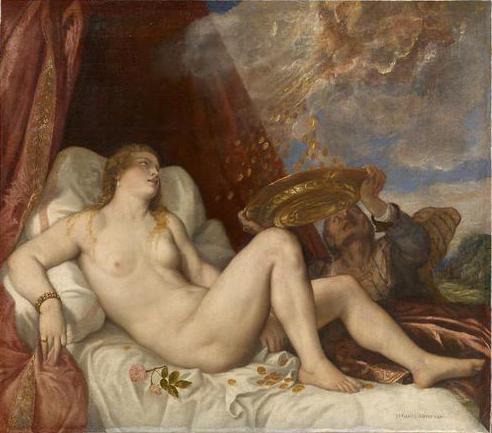Titian Divine - the so-called outstanding painter of the Renaissance was called by his contemporaries. To be on the "sight" of his brilliant brush was a great success. The painter, who created dozens of portraits of kings, dukes, cardinals and other representatives of the highest nobility, forever immortalized their faces and names on their canvases.
The birth of style
Titian Vecellio was not even twelve years old when he arrived in Venice and began to study the basics of painting. Here he met Giorgione, with whom he wrote saints for monasteries and temples. Titian's artistic style at that time was distinguished by grace and purity of colors. Studying the work of Michelangelo, carefully examining Raphael's canvases, Titian synthesized his own style.
Artistic addictions of the master
He created an incredible number of accurate and deep portraits and painted a lot of biblical and mythological paintings, among which there is a picture of Danae. Titian was attracted by shades of character, especially the look, the movement of the hands, the rotation of the head in the image of the heroes of legends and myths. The painter did not focus on their divine status, but on human manifestations.
The mystery of Danai
The Greek myth of Danae tells us that her father Acrisius imprisoned her daughter in the tower so that she would never give birth to a child whose king, according to the oracle, King Acrisius was to die. But the god Zeus penetrated the captive, turning in the golden rain. After a love visit, Danae gave birth to a son Perseus. This story inspired many artists, the beauty in the tower was written by Correggio, Rembrandt, Titian. Danae became the heroine of four canvases in the great heritage of Titian.
Early option
The master created the first picture in 1546. It is called “Danae with a Golden Rain” and depicts a languid young girl, spread out on a crumpled bed after a dream full of sweet dreams. The triumph of life and harmony is proclaimed in this early work by Titian. Danae is depicted in a dreamy expectation. Without a surprise, she looks at the gold gushing from the clouds that came from nowhere, and next to amazement and delight, this phenomenon is observed by Cupid with an arrow and a quiver thrown over his shoulder. The figure of the young woman seems to glow from the inside, the rounded lines of the body are filled with grace and gentle beauty. Colors gently blend into each other. This painting is now stored in the National Museum of Capodimonte in Italy.
What was the second canvas
In the Madrid Prado Museum, another painting is exhibited, which Titian created for this plot. “Danae” this time was written by order of the Spanish king for Crown Prince Philip II, between 1553 and 1554. In this picture, the plot is more consistent with the legend. There is no longer a pink-cheeked Cupid, the old nurse of the prisoner substituted her apron under the golden jets. The color of the canvas was changed by luminous romantic colors, now they mysteriously flicker, and we have an atmosphere in which there is tension and strong emotions. There is no coverlet on the girl that was casually thrown over her hips on an early canvas. Linen on the bed, curtains over the bed are made of expensive materials. A royal dog curled up around a pillow in a jeweled collar.
Features of the third canvas
Titian's canvas gained such popularity that orders were poured one after another. The third version of Danae expresses contrast even more clearly, giving rise to dynamics and drama. A dog disappeared from the canvas, and in the clouds, from which gold coins are strewed, the face of Zeus inspired by love peeps out. Here, the unique manner in which the mature Titian is distinguished is entirely triumphant. Danae is painted with sculptural lines and soft colors emitting light, while the image of the old nurse is dominated by greenish-sand tones. All together creates an incomparable harmony in color. This canvas can be seen now in the St. Petersburg Hermitage.
Late Danae
The fourth version of the picture is full of incredible sensuality, the action here is developing rapidly and irresistibly. By 1564, when this canvas was painted, at the peak of his ingenious skill Titian creates. Danae is created plastic and reverent. Transitions from one color to another are made with the greatest taste and demonstrate a delightful color scheme, permeated with light and air. The anthem to the beauty of the human body is combined on canvas with an expressive image of the subtlest overflows of mood and mental movements. Danae looks at Zeus with a seductively restrained passion, and he is directed to his beloved with all the power of an unquenched feeling.

There is a lot of gold in the picture, contrasting harmoniously with purple and azure. It is no coincidence that the wonderfully delicate pink flower and the great Titian throws onto the bed of the beautiful woman and several gold coins waking up from the cloud. “Danae” (the description of the late canvas cannot be left without mentioning the composition) is depicted here in all the charm of a multifaceted and deep perspective, new to the painting of those times.
Three-dimensional space and camera angles are presented in theatrical dynamics and create the illusion of a living expressively action. A beautiful girl takes a golden shower as a sign of divine love, and for her old servant, catching coins on a tray, this is a fee for aiding and silence. The painting adorns the exposition of the Austrian Kunsthistorisches Museum in Vienna.